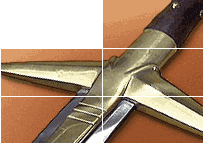
 |
|
|
From Lance to Pistol
The Evolution of Mounted Soldiers from 1550 to 1600 An article by Gordon Frye "There are 18 cornets supposed to consist of 80 troopers apiece. In mine there were 75: some are much larger; but the one supporting mine had only 40 or 45. The ranks behind the flag of this unit are filled up with men who have only buff coats and pistols: of gentlemen wearing cuirasses and closed helms, and with horses worth 50 gold crowns, there are, except in the very largest cornets, not more than ten or a dozen. These are called the 'gens de combat', and these decide the day"1
The change from the overwhelming dominance of the fully armed and armoured cavalryman astride a barded (armoured) horse, to the general acceptance of lighter cavalry, with riders armed with pistols and sword, was the work of less than a century. From the days of the late 15th Century, when a "light" cavalryman was fully armoured and the only major point of difference between him and a heavy cavalryman was the cost and armouring of his horse, there was a dramatic shift in tactics, weapons and outlook in the military circles of Western Europe by the end of the 16th Century.History 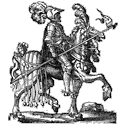 Despite common belief, the heavy infantry of the Swiss and English models had been dominating European battlefields for some time prior to the dawn of the 16th Century. Compared to the Swiss pike phalanx or the English longbowmen backed by men-at-arms on foot, the heavy cavalry of the feudal pattern, peopled by ungovernable nobles, was as much a liability as a force to be reckoned with. However, French King Charles VIII's compagnies d'ordonnance, consisting of fully armoured nobles and gentry (men-at-arms or gendarmes) mounted on armoured horses, organized and disciplined as well as any force in Europe at the time, changed that in the course of a single battle. When they hit the Italian Condottieri heavy horse at Fornovo in 1495 the Italians were scattered like ninepins, leaving their infantry to be slaughtered at leisure. At Ravenna in 1512, French knights rode completely through a Landsknecht pike-square doing little damage, but proving that they were virtually impregnable. However, such organizations were incredibly expensive to maintain, and only the French crown was capable of doing this to any serious degree. There was an attempt by the Burgundian Dukes and their Habsburg heirs to copy these compaigne d'ordonnance with their own, but they were few in number. When Henry VIII of England invaded France in 1513 he had enormous difficulty in collecting a reasonable number of Men-at-Arms and had to make due with demi-lancers, men wearing only half-armour or three-quarter armour, riding unarmoured horses, and hiring Burgundian (i.e., Netherlandish) heavy horse to compensate for the lack.
Despite common belief, the heavy infantry of the Swiss and English models had been dominating European battlefields for some time prior to the dawn of the 16th Century. Compared to the Swiss pike phalanx or the English longbowmen backed by men-at-arms on foot, the heavy cavalry of the feudal pattern, peopled by ungovernable nobles, was as much a liability as a force to be reckoned with. However, French King Charles VIII's compagnies d'ordonnance, consisting of fully armoured nobles and gentry (men-at-arms or gendarmes) mounted on armoured horses, organized and disciplined as well as any force in Europe at the time, changed that in the course of a single battle. When they hit the Italian Condottieri heavy horse at Fornovo in 1495 the Italians were scattered like ninepins, leaving their infantry to be slaughtered at leisure. At Ravenna in 1512, French knights rode completely through a Landsknecht pike-square doing little damage, but proving that they were virtually impregnable. However, such organizations were incredibly expensive to maintain, and only the French crown was capable of doing this to any serious degree. There was an attempt by the Burgundian Dukes and their Habsburg heirs to copy these compaigne d'ordonnance with their own, but they were few in number. When Henry VIII of England invaded France in 1513 he had enormous difficulty in collecting a reasonable number of Men-at-Arms and had to make due with demi-lancers, men wearing only half-armour or three-quarter armour, riding unarmoured horses, and hiring Burgundian (i.e., Netherlandish) heavy horse to compensate for the lack.This paradigm of the man-at-arms in full armour wielding a heavy lance began to be challenged in the mid-1540s with the introduction in Germany of a new invention-the wheellock pistol. Although there had been experiments with mounting up men using matchlock harquebuses, there was no way that they could even hope to stand against a charge by a serious man-at-arms; however, within a few years of the invention of the pistol (circa 1530), German heavy cavalry began to add such novelties to the arsenal of weapons carried on their horses. Accounts of the German siege of Stuhlweissenburg, Hungary, in 1543, provide the earliest references to cavalry use of the wheellock in combat. The next year, in the battle of Ceresole, the German Emperor Charles V's Imperialists equipped the second rank of their Landsknecht pikemen with pistols. The emperor's ally, Henry VIII of England, in his Enterprise of Boulogne in the same year, complained that the German cavalry he hired wasn't real heavy cavalry at all, but merely pistolier cavalry. 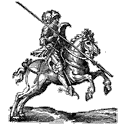 By the 1550s, the German heavy cavalrymen had virtually completely discarded the lance in favor of a pair or more of wheellock pistols. They were considered heavy cavalry, in full or three-quarter armour, but using their pistols as their primary offensive weapons. One of the results of this was to force armourers to make their newer armours pistol-proof, which added to the weight and expense of the suit; in looking for ways to reduce the load carried by the horses, one of the first things to go were the heavy armoured bardings worn by the horses themselves, and the practice was extinct long before the new century. Thus, by 1560 the German heavy horse was already significantly lighter than it had been some thirty years previous.
By the 1550s, the German heavy cavalrymen had virtually completely discarded the lance in favor of a pair or more of wheellock pistols. They were considered heavy cavalry, in full or three-quarter armour, but using their pistols as their primary offensive weapons. One of the results of this was to force armourers to make their newer armours pistol-proof, which added to the weight and expense of the suit; in looking for ways to reduce the load carried by the horses, one of the first things to go were the heavy armoured bardings worn by the horses themselves, and the practice was extinct long before the new century. Thus, by 1560 the German heavy horse was already significantly lighter than it had been some thirty years previous.A further challenge to the supremacy of the heavy horse was the introduction to European armies of the mousquette, or musket, in the late 1540s. A heavy firearm of up to .85 caliber, often weighing in the range of 20 pounds and needing a forked rest to hold it in firing position, the musket could smash through virtually any armour of the day. Although the musket remained rare up to the end of the century (the caliver, smaller than the musket overall and of much smaller bore, was the predominant "shot" in all European armies) its very presence gave pause to the most stouthearted cavalrymen. 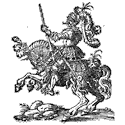 True light cavalry could, of course, be found in most European armies of the day. The French and Italians hired Albanian Stradiots; Germans hired Hungarians; the Spaniards had their own national light horsemen-the Jinetes or Genitors, armed with shield and javelin; the English relied upon their own border horsemen (the French were known to hire Scottish border horsemen as well). All of these light horse cavalrymen were from the fringes of their own national lands, skilled in the rough-and-tumble of raid and counter-raid, ambuscade and pillage that defined life on the borderlands of nations and cultures. They were of enormous usefulness to their masters in acquiring information through scouting and screening, and doing all of the myriad things that many a gentleman found below his station to attend to, but could make or break a campaign in a very short span of time. Such frontiersmen remained confined to the duties of scouting and screening (duties that a later generation of cavalrymen would find to be the primary reason for the very existence of cavalry), but they were not in any way considered to be worthy of much note on the actual battlefield. Rather, they were useful only for their skills of scouting and foraging. Most were viewed as little better than barbarians as likely to plunder their own baggage train as the enemy's.
True light cavalry could, of course, be found in most European armies of the day. The French and Italians hired Albanian Stradiots; Germans hired Hungarians; the Spaniards had their own national light horsemen-the Jinetes or Genitors, armed with shield and javelin; the English relied upon their own border horsemen (the French were known to hire Scottish border horsemen as well). All of these light horse cavalrymen were from the fringes of their own national lands, skilled in the rough-and-tumble of raid and counter-raid, ambuscade and pillage that defined life on the borderlands of nations and cultures. They were of enormous usefulness to their masters in acquiring information through scouting and screening, and doing all of the myriad things that many a gentleman found below his station to attend to, but could make or break a campaign in a very short span of time. Such frontiersmen remained confined to the duties of scouting and screening (duties that a later generation of cavalrymen would find to be the primary reason for the very existence of cavalry), but they were not in any way considered to be worthy of much note on the actual battlefield. Rather, they were useful only for their skills of scouting and foraging. Most were viewed as little better than barbarians as likely to plunder their own baggage train as the enemy's.With the beginnings of the French Wars of Religion in 1562, there began the transition from the domination of the old sort of heavy cavalry to what was then considered to be light horse. Some types of mounted soldiers who were hardly considered to be cavalrymen at all, but only mounted shot, were to become the standard for cavalry by the middle of the next century. Weapons and Tactics The tactical formation of the French compagnie d'ordonnance was referred to in the day as en haye (in line). This was a thin formation, being seldom more than two ranks deep, but on a very broad front in order to take full advantage of the heavily armoured men and horses wielding the old, heavy lance at a full gallop. Originally, these units were organized in units of 100 Lances. In the terminology of the time, a Lance consisted of the man-at-arms, his horse, his lance and his fully armed and mounted retainers. The retainers, not always on barded horses, would usually form the second rank, their horses being protected by the heavy armour of the first rank's horses. In some cases a Lance could consist of upwards of 700 men, but in the later days of the Italian Wars, the Lance was reduced to only the actual man-at-arms and an attendant mounted on a nag and not expected to fight in the line of battle. The French man-at-arms was armed with the heavy, hourglass-shaped lance and an arming sword and armoured cap-a-pie (head-to-foot). His horse was a large, expensive stallion, similarly armoured (at extreme expense) and almost impregnable to pikes. 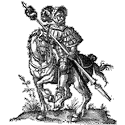 German heavy cavalry at this time favored the same full armour for man and horse, but was of a far different bent, tactically. The narrow fronted caracole formation, which relied upon the momentum of a deep column, was the preferred German formation, even when using the lance. One manual from the 1480s suggested a front of 18 horses, 9 deep with a small formation in front to act as a wedge, as being optimum for a 200 man company2. This formation remained largely unchanged even when the pistol became popular, but the pistol inspired a new technique. The front rank of German heavy cavalrymen or reiters (from Schwartzreiter, meaning a rider wearing the distinctive blackened armour common to the pistoliers) would come forward at the trot, discharge its pistols at the enemy, then ride off to expose the second rank, and so on. After firing, the ranks were to ride to the rear and reload, coming forward again as needed. It is interesting to ponder whether this technique was adopted from the infantry technique for sustaining constant harquebus fire, or from the tactics of the Genitors of Charles V, who, while Emperor of Germany was also King of Spain and happily filled his armies with subjects from all his realms.
German heavy cavalry at this time favored the same full armour for man and horse, but was of a far different bent, tactically. The narrow fronted caracole formation, which relied upon the momentum of a deep column, was the preferred German formation, even when using the lance. One manual from the 1480s suggested a front of 18 horses, 9 deep with a small formation in front to act as a wedge, as being optimum for a 200 man company2. This formation remained largely unchanged even when the pistol became popular, but the pistol inspired a new technique. The front rank of German heavy cavalrymen or reiters (from Schwartzreiter, meaning a rider wearing the distinctive blackened armour common to the pistoliers) would come forward at the trot, discharge its pistols at the enemy, then ride off to expose the second rank, and so on. After firing, the ranks were to ride to the rear and reload, coming forward again as needed. It is interesting to ponder whether this technique was adopted from the infantry technique for sustaining constant harquebus fire, or from the tactics of the Genitors of Charles V, who, while Emperor of Germany was also King of Spain and happily filled his armies with subjects from all his realms.Needless to say, this formation, while theoretically interesting and perhaps even useful against pike-armed infantry, left something to be desired when fighting determined lancers. Sir Roger Williams, in his Brief Discourse on Warre (1590), has this to say about such tactics: "Considering the resolute charge done with the might of their horses, the Launtiers are more terrible and make a farre better shew either in Muster or Battaile. For example, when the Almaines, during the time they carried Launces, carried a farre greater reputation than the do now being pistolers named Rutters. The most Chiefes of Souldiers of accompt are armed at the proofe of the pistol. If the leaders commaund their troupes to spoyle horses, the Launces are more sure, for divers pistols faile to go off: if charged it shakes in a man's hand so that often it touches neither man nor horse; if the charge bee too little it pierceth nothing to speak of. True it is, being pickt and chosen, the pistoliers murther more… but I was often in their companie when they ran away, three from one Launtier in great troupes and small… Without doubt, the Pistol discharged hard by, well charged, and with judgement, murthers more than the Launce; out of a hundred pistoliers, twentie nor scarce tenne at the most do neither charge pistol nor enter a squadron as they should, but commonlie and lightly always they discharge their pistols eight and five score off, and so wheele about: at which turnes the Launtiers charge then in the sides, be they well conducted… The Launtiers have or ought to have one pistol at the least."3
But there were contrary voices who maintained the superiority of the Pistol over the Lance. François de la Noue, as steady and experienced an old War Horse as Sir Roger, had this to say as one of his "Paradoxes":"Whereupon I will say that although the squadrons of the spears [i.e. lances] do give a gallant charge, yet it can work no great effect, for at the outset it killeth none, yea it is a miracle if any be slain with the spear. Only it may wound some horse, and as for the shock, it is many times of the small force, where the perfect Reiter do never discharge their pistols but in jointing, and striking at hand, they wound, aiming always either at the face or the thigh. The second rank also shooteth off so the forefront of the men-or-arms squadron is at the first meeting half overthrown and maimed. Although the first rank may with their spears do some hurt, especially to the horses, yet the other ranks following cannot do so, at leas the second or third, but are driven to cast away their spears and help themselves with their swords. Herein we are to consider two things which experience hath confirmed. The one, that the Reiter are never so dangerous as when they be mingled with the enemy, for then be they all fire. The other, the two squadrons meeting, they have scarce discharged the second pistol but either the one or the other turneth away. For they contesteth no longer as the Romans did against other nations, who oftentimes keep the field fighting two hours face to face before either party turned back. By all the afore-said reasons, I am driven to avow that a squadron of pistols, doing their duties, shall break a squadron of spears."4
There were still divisions between heavy and light cavalry throughout the 16th Century. The heavies, of course, were fully armoured and armed with the heavy lance. The Germans considered their pistoliers to be heavy cavalry as well, though they were seldom, if ever, mounted on barded horses. Henry Barret, in his Theorik and Practike of Moderne Warres (1598), defined the arms of the cuirassier as consisting of "a petronell peece, which is with snaphaunce, or one long pistol, as the French now use them, fastened in a case of leather, at the saddlebow, or else a pair of pistols in one case as to the Reytters".What we would define as the medium cavalry of the day was what the English referred to as a demi-lancer. They wore half-suits of armour, carried a light 12-16' lance, and rode strong horses (generally geldings rather than stallions). The French chevaux-legers, described by Martin du Bellay in his treatise Discipline Militaire (1548), were armed the same way and served the same function. While both would be placed in line of battle, they were never expected to be able to stand up to a charge by heavy horse. For the most part they were an attempt to cheaply furnish an army with heavy horse, without the horrendous expense of the full man-at-arms. They were seldom referred to as medium horse. Light cavalry remained in its scouting role. Again, Sir Roger explains its function: "The service of all Light horsemen consists chieflie in the marching of great marches, (cavalgades, the strangers terme it) I mean, to surprise Companies a farre off in their lodgins, or marches; likewise to defeat convoyes, and to conduct convoyes, as much to say, direct it to spoyle necessaries that come to furnish their enemies, and to conduct necessaries to furnish their own campe or service. Also to scout and discover, to spare the armed men, I mean the Launtiers, and like horsemen; likewise both to conduct and spoyle foragers, with the like services."5
Such cavalrymen remained lightly armed and armoured. The English border horsemen usually were armoured with a mail shirt, a burgonet or other light helmet and a steel target. Their arms consisted of a border lance (a light lance of no more than 10-12'), a sword and, by the middle years of the century, a case (pair) of pistols in German-style holsters. Being well-versed in the skills of the light cavalryman from their years of experience raid and counter-raid on the Anglo-Scottish Border, these Border Prickers, as they were sometimes known, made wonderful scouts and raiders.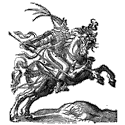 The English experience in warfare in this period was in primarily in the Low Countries and in Ireland. Cavalry seldom found serious deployment in the Low Countries, which have very little, geographically, to recommend them for cavalry actions. As usual, England could not come up with sufficient heavy men-at-arms, but could provide demi-lancers. These formed the bulk of the English mounted troops in the Netherlands during the various campaigns during the late 16th Century. Although there were a few sharp cavalry engagements there, it was a heavily urbanized land much cut-up with dikes and watercourses, so sieges were more common.
The English experience in warfare in this period was in primarily in the Low Countries and in Ireland. Cavalry seldom found serious deployment in the Low Countries, which have very little, geographically, to recommend them for cavalry actions. As usual, England could not come up with sufficient heavy men-at-arms, but could provide demi-lancers. These formed the bulk of the English mounted troops in the Netherlands during the various campaigns during the late 16th Century. Although there were a few sharp cavalry engagements there, it was a heavily urbanized land much cut-up with dikes and watercourses, so sieges were more common.In Ireland, fighting a dispersed and savage foe in a wild and uncivilized countryside, the usefulness of heavy cavalry was nil, whereas the border horsemen were in their element. Though English commanders kept a number of demi-lancers with them, most of the serious fighting with Irish horsemen, and indeed much with the Irish footmen, was done by the Borderers. As in all guerrilla campaigns, it is the forward scouts and foragers who take the brunt of the fight and in this the Borderers excelled. In the same way, and under similar conditions, the light cavalry of Spain was the primary force in the exploration and conquest of the New World, where mail shirts, burgonets or other open helmets, and leather or quilted cotton coats, provided almost all of the defensive arming of the Spanish Conquistadors. On the other hand and at the same time, huge battles in France were decided by heavy cavalry. In fact, the French experience was far different from that of English, Dutch and Spanish. Cavalry and the French Wars of Religion When the disagreements between Catholics and Protestant Huguenots in France broke into open warfare in 1562, the French had been entangled in foreign wars for generations and had a wealth of both experience and otherwise unoccupied soldiers to fill the ranks of the warring parties. Although the politics of the civil wars are beyond the scope of our study, suffice it to say that the tendencies of the factions were illustrated not only in their politics and religion, but in their tactics as well. The Crown, for much of these civil wars, was held by the degenerate sons of Catherine d'Medici. As she was a staunch supporter of both the Papacy and the Catholic Church in France, the old infantry regiments, the Swiss, and the compagnies d'ordonnance supported the Royalist/Catholic armies for as long as they remained in power. The various factions of Royalist supporters were of the sort who clung to the older ways as well and, with the compangnies d'ordonnance, remained steadfast supporters of heavy horse as typified by the man-at-arms wielding the heavy lance. The Swiss retained their old reputation as steady, unbreakable infantry dominated by pikes, while the French infantry regiments were far more heavily armed with firearms than pikes. 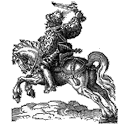 At first, the Huguenots were armed as their opponents with the heavy lance, and the early battles of the French wars of religion were fought with that weapon. However, the Huguenots were fairly quick to adopt the pistol as their primary offensive weapon, as had the bands of German Protestant reiters who came to the aid of their co-religionists. One of the foremost commentators of the military actions of the French Wars of Religion was Francios de la Noue, and it was his opinion that the Germans, by the use of their caracole technique, violated traditional principals of Cavalry. Specifically, he noted that the caracole's distinctive pattern of a front rank advancing, firing and retiring created firepower, but not shock. As Sir Roger Williams noted, this was a poor strategy when faced with an opponent who was not content to receive the fire without violent response. However, the Huguenots of, first, the Prince of Conde', and, later, of Henri of Navarre, solved this problem of the use of the pistol on horseback. Their cavalry, after discharging pistols at the enemy, drew swords and charged into the ranks of their opponents. The French also adopted pistols of longer barrel and smaller bore than the heavy German "puffer," and the increased muzzle velocity improved the armour-piercing ability of the arms.
At first, the Huguenots were armed as their opponents with the heavy lance, and the early battles of the French wars of religion were fought with that weapon. However, the Huguenots were fairly quick to adopt the pistol as their primary offensive weapon, as had the bands of German Protestant reiters who came to the aid of their co-religionists. One of the foremost commentators of the military actions of the French Wars of Religion was Francios de la Noue, and it was his opinion that the Germans, by the use of their caracole technique, violated traditional principals of Cavalry. Specifically, he noted that the caracole's distinctive pattern of a front rank advancing, firing and retiring created firepower, but not shock. As Sir Roger Williams noted, this was a poor strategy when faced with an opponent who was not content to receive the fire without violent response. However, the Huguenots of, first, the Prince of Conde', and, later, of Henri of Navarre, solved this problem of the use of the pistol on horseback. Their cavalry, after discharging pistols at the enemy, drew swords and charged into the ranks of their opponents. The French also adopted pistols of longer barrel and smaller bore than the heavy German "puffer," and the increased muzzle velocity improved the armour-piercing ability of the arms.Another major, and perhaps the primary, difference between the Catholic and Huguenot armies was in the method of deploying their cavalrymen. While tactics dictate weapons, weapons also dictate tactics, and while the Catholics clung to the old en haye formation and heavy lance, the Huguenots adopted the German column of pistoliers, usually of six ranks or more. In his Discours Militaire de la Noue maintains that the best formation for 100 men would be a front of some 14 or 15 horsemen, 6 or 7 ranks deep. This formation was somewhat shallower than the German model, but still far deeper than the en hay tactic of the Catholic Royalists. This change accompanied the modified caracole technique described above. With the pistol effectively being used as a long-range lance, cavalry could reduce the front rank of their opponents before the actual physical contact of the two forces, allowing them to use their weight of numbers in column to punch through the already thin, and now much reduced, line of lancers. Time and again, the Huguenot heavy horse put the Royalist, and, later, Catholic League, cavalry to flight after reducing them to shambles through the combination of the pistol, modified caracole and the discipline to use them together effectively (and to not disperse in search of plunder after the initial clash as well). Blaise Montluc made note of the problems of the lance vs. the pistol: "With these arms (pistols) one can better fight en masse than with lances, because if you do not fight in line the lancers get into more difficulty, and the fighting in line is not as safe as in massed formations". Likewise, La Noue mentioned that, "it is a miracle if any be slain by the Speare". 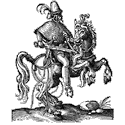 The most impressive illustration of the new Huguenot cavalry tactics was in the battle of Coutras (October 20, 1587), when Henri of Navarre, as leader of the Protestant Cause in France, was confronted by Henri III's favourite, the Duc de Joyeuse, with the Royal Army. With 24 coronets of gendarmerie (approximately 2,000 heavy cavalry and some 8,000 infantry), Joyeuse marched on Navarre's army. The Protestants had only 5,000 infantry and 1,300 horse, but the infantry were veterans and they faced courtly novices.
The most impressive illustration of the new Huguenot cavalry tactics was in the battle of Coutras (October 20, 1587), when Henri of Navarre, as leader of the Protestant Cause in France, was confronted by Henri III's favourite, the Duc de Joyeuse, with the Royal Army. With 24 coronets of gendarmerie (approximately 2,000 heavy cavalry and some 8,000 infantry), Joyeuse marched on Navarre's army. The Protestants had only 5,000 infantry and 1,300 horse, but the infantry were veterans and they faced courtly novices.Henri formed his cavalry, consisting of pistoliers in full armour, in four blocks, with infantry between the blocks to add firepower. Joyeuse formed his cavalry in the old en hay formation, with fully armoured gendarmes armed with the heavy lance. "All the front rank was formed of counts, marquises, barons and great lords"6, and overlapped the Huguenot line on either side. Joyeuse began his charge, but his cavalry broke into a gallop too early, scattering the formation. When Henri's columns hit the two ranks of Catholic nobles, the issue was settled in five minutes, with nothing but the ransom of prisoners left to be decided after some desultory slaughter. In the words of Tavannes, "The large pistols make close action so dangerous that everyone wants to leave, making the fights shorter". As noted in the quote at the beginning of this article, it was rare for a French cavalry cornet to fully fill out its requirements of armed and accoutered men. Thus, as in the days of old, the most heavily armed men on the best horses formed the front ranks, leaving the less well equipped men to fill in the rear ranks. This was common in all armies at all times, of course, but it seems to be more the rule than the exception in times of civil strife. The practice also pointed to the future, for although these gens de combat might win the day, their day was, in fact, numbered. The fellows in the rear rank, armed with pistols and buff-coats, would replace the armoured horseman in the next century. Cavalry and the Dutch Revolt 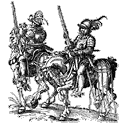 While the topography of France was close to perfect for cavalry actions, that of the Low Countries was not, as the English learned in Henry VIII's time. As then, most of the warfare of the conflict between the King of Spain and his Netherlands subjects was conducted through sieges, with infantry bearing the brunt of the fighting. Sir Roger Williams cut his teeth in this fighting, first siding with the Spanish and the Dutch. Thus, his comments above on lancers vs. pistoliers are especially valuable.
While the topography of France was close to perfect for cavalry actions, that of the Low Countries was not, as the English learned in Henry VIII's time. As then, most of the warfare of the conflict between the King of Spain and his Netherlands subjects was conducted through sieges, with infantry bearing the brunt of the fighting. Sir Roger Williams cut his teeth in this fighting, first siding with the Spanish and the Dutch. Thus, his comments above on lancers vs. pistoliers are especially valuable.Spanish cavalry retained the lance but the Dutch cavalry, made up of English, German and Scottish units, were decidedly based on the pistolier model. Even the Walloon cavalry, consisting of southern Netherlanders in the Spanish Service, were pistoliers. And so it remained until Spain's Phillip III decreed abandonment of the lance in the early years of the 17th Century. Much of the work done by cavalry in the Dutch Revolt was in the form of scouting, foraging and harassing the enemy. The heavy cavalry, which by the second half of the 16th Century was becoming lighter and lighter, was retained to protect the infantry from sudden raids by light cavalry and infantry, and for the few cases in which the opposing cavalry forces were able to come to grips with one another. There were, however, a few notable cavalry actions. At Tournhout in 1597, for example, Maurice of Nassau's pistoliers defeated a mixed force of Spanish lancers and infantry caught in a retreat. The pistoliers rode down the lancers and broke them, and then proceeded to defeat the infantry in detail. Commentators of the day concluded from this battle that pistolier cavalry could face down lancers and win, then route the opposing infantry. Conclusion People often question why armour went out of fashion on the battlefield, and though they may rightly identify firearms as the root cause, that is far from the whole story. Too, military historians often wonder aloud why the lance, which was re-adopted with enthusiasm in the middle of the 19th century, was allowed to languish between 1600 and 1800. I believe the causes are twofold. 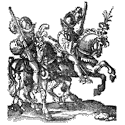 First, although the gradually centralizing monarchies were reaping in greater and greater funds to pay their armies, at the same time, armies were getting larger and larger. Any method of reducing costs was adopted with relish: thus, the gradual diminution of the old compaigne d'ordonnance as well as the reduction in armour. Heavy armour is expensive to produce, and bardings require a strong, well-trained horse to bear its weight as well as the gendarme and his lance to the point of impact at speed. Even without bardings, the cavalry charge required a strong, courageous horse to bear the weight of the armed man in combat.
First, although the gradually centralizing monarchies were reaping in greater and greater funds to pay their armies, at the same time, armies were getting larger and larger. Any method of reducing costs was adopted with relish: thus, the gradual diminution of the old compaigne d'ordonnance as well as the reduction in armour. Heavy armour is expensive to produce, and bardings require a strong, well-trained horse to bear its weight as well as the gendarme and his lance to the point of impact at speed. Even without bardings, the cavalry charge required a strong, courageous horse to bear the weight of the armed man in combat.Second, it became more efficient to utilize pistoliers since, as proved by the Huguenots and the Dutch, the pistolier when properly led was every bit the match of the lancer. By the beginning of the 17th Century, then, the lancer was an anachronism. Although beloved of the authors of manuals and military treatises, he was seldom seen again on Western battlefields until re-introduced by Napoleon's Poles 200 years later. As firearms continued to improve, armour continued to diminish in value as pieces heavy enough to be of service became too heavy to bear for long periods of time. Thus, the mounted opponents of the Thirty Years War and the English Civil War met each other with pistol and sword. About the Author Gordon Frye has had a deep interest in history and weapons of all sorts from early childhood, earning a Master of Arts degree in Western History in 1982. He has worked as an assistant Reenactor Coordinator for Cavalry for such historical films as Ride with the Devil and The Patriot, having taken part in a host of others. His present passion is Renaissance Cavalry, and is presently living in the Puget Sound area of Washington with his wife, two horses, three chickens and five cats. Author's Thoughts Oddly enough, the mounted forces of the 18th century fought with the sword, leaving their pistols in pommel holsters, for the most part. Why, after two centuries of ever-increasing efficiency in the development of hand-held weapons, were pistols relegated to such a subservient position? Perhaps the cavalry sword overshadowed the pistol for the same reason the introduction of the socket bayonet shifted reliance from firepower to the "moral suasion" of the bayonet. That the sword and bayonet would dominate European battlefields and the minds of military theorists into the early 20th Century may be a matter more for the psychologist than the historian, but I leave you with a theory. With the slaughter engendered by the mass armies of the 16th and 17th centuries, and their bloody legacies of destruction and devastation, primarily through the efficient use of firearms, the professional soldiers of the centralized monarchies may have recoiled at the horrors wrought by such efficiency and sought to control them in some manner. If for no other reason, it was bad for business to kill off one's own peasantry and it was too expensive to kill off the professional soldiers who became the standard for European nations. Cold steel reduced casualties. The introduction of the Colt's revolving pistol to the 1840s Texas frontier, in the hands of Hays' Rangers, led to a repeat experiment of lance vs. pistol, once again to the detriment of the lancer and once again sparking a revolution in the formation and equipping of armies. Notes 1. Oman, Sir Charles W. C. History of the Art of War in the 16th Century, p 406; footnote from d'Aubigné, p 215 2. Ibid, p 83 3. Williams, Sir Roger. Briefe Discourse on Warre, p 50 4. François de la Noue, The Politick and Military Discourses of the Lord de la Noue, translated by Aggas, London 1587, ppg 201-202 5. Ibid 6. Oman, op. cit., p 475, d'Aubigné |
|